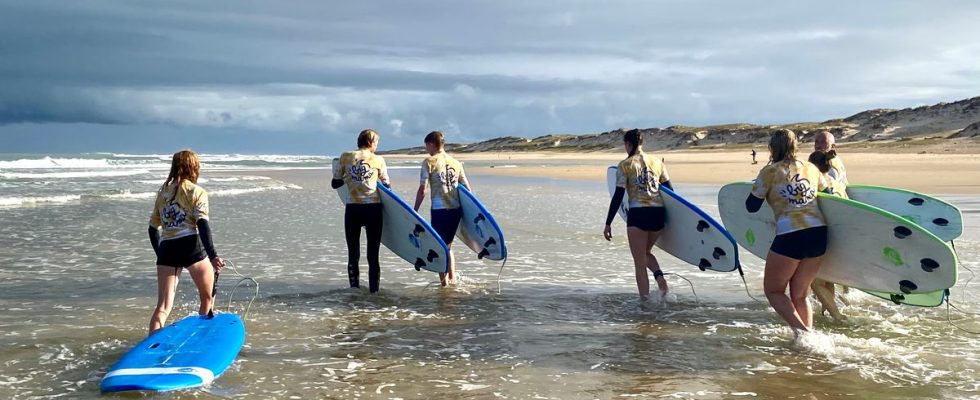The slender blonde surfer with perfect proportions holding her board in front of the ocean is one of the images that surf brands still love to sell their products. But we don’t see them much at work on a board, and for good reason, the majority of those who are highlighted in these advertisements are not real sportswomen but professional models.
“In 2018, when I was working in the artistic direction at Surfer session missI wanted muscular surfers with broad shoulders for the shoots, but the brands preferred fine girls with physical standards that do not correspond to the reality of real surfers”, testifies Jeanne, 28, an illustrator who created her brand Les surf girls.
Jeanne wanted to warn about this problem, which particularly affects surfing, which is practiced naked and where one exposes oneself to the gaze of others, by representing very round women. “I pushed the pendulum very far to challenge and, at first, it made a little noise,” she recalls. I even had some clients who asked me to refine my drawings, but that doesn’t happen anymore”. By proposing new representations of the female body with which women can identify, she hopes that those who are round will not hesitate to try their hand at surfing.
Unsuitable material beyond the XXL
“We have to give everyone the chance to surf, and here we adapt to all sizes” assures Romain, manager of the Big Mama School surf school, in Lacanau, Gironde. For surf instructors, there is a psychological brake to lift for these plump people who often tell themselves that they are not able to surf. But, for those who push the door of the schools, practical problems arise all the same. The board must be adapted to the weight of the surfer to ensure the best possible lift. “The problem we have is that, for the widest boards, the surfers had a hard time crossing their arms to row, they are less efficient”, points out Manex Sallaberry, manager of the Hendaia school, at Hendaye, in the Pyrénées-Atlantiques.
Wetsuit models for women rarely exceed XXL, i.e. a 46 in French size. “We find XXXL at Decathlon for men, points out Manex Sallaberry. You can also surf in a swimsuit, but the wetsuit prevents friction with the board, which can cause irritation”. Nadia Ghali, vice-president of the surfing federation in charge of diversity, evokes a recent example of the difficulties of equipping strong women. “A young girl who weighs 120 kg had to order an XXXL suit, but the seams are not well sealed… There is still a long way to go,” she believes.
Cuts and textiles adapted not to hide the shapes but to highlight them
About four years ago, Rip Curl, one of the great surfing brands, started to engage in self-criticism. The brand received messages explaining that it was too exclusive and some of the employees also regretted not being able to wear Rip Curl swimsuits, because of their shapes.
“We see on the beach that the roundest women tend to wear shorties, but for some time now they have found it easier to wear more indented combinations”, says Jeanne with satisfaction. This is the spirit in which Rip Curl has redesigned some of its cuts and materials, while adding a size (XXL) to certain models. “Rather than offering a lot of reinforcements, we want to get curvy women to wear things they wouldn’t have thought of wearing, such as low-cut necklines and swimsuits at the opening of the thigh,” explains Valérie Wieser, female design manager at Rip Curl. To relieve the complexes of women who find it difficult to assume their curves, this is also played out during parades: “for that of our seminar, last May, we had not only skinny girls, but all sizes”.
Recently, the brand made a one-size-fits-all technical jersey “circularly fitted without seams and very stretchy”, explains Valérie Wieser. Result: it highlights very different morphologies from XXS to XXL and will be relaunched for next year’s collection. “The quality of the materials is the sinews of war, believes this specialist. The ones that have as much lycra as possible are really stretchy”. On the triangle swimsuit, a basic, the brand now offers D cups and these new models have been very successful.
Still a long way to “more naturalness and authenticity”
For wetsuits, the matter seems more difficult: “because neoprene is less stretchy than lycra, points out Valérie Wieser. For summer wetsuits, which are thinner, it’s fine, but for the others that are 4 mm thick, it’s more complicated. Even for men, there is no XXXL (at Rip Curl)”. The brand, whose head office is in Hossegor in the Landes, has a workshop that allows tailor-made alterations for specific needs.
Among brands more oriented towards the general public, things are also moving. “Olaian, a Decathlon brand, has been creating swimsuits up to 56 for a few years, whereas it is difficult to go over 44 in some shops”, appreciates Jeanne. Roxy, another major surfing brand, has partnered with the influencer “Curvy surfer girl”, and has chosen a model with the build of a surfer for one of its campaigns. Neither Roxy nor Decathlon wished to respond to requests from 20 minutes.
“On the ground we can see that things have changed, but, above, it has to be in line”, concludes Nadia Ghali. At the federation, she strives to defend “a collective practice in an individual sport with more naturalness and authenticity”.

